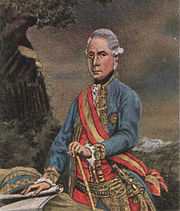
Symphony No. 69 (Haydn)
Encyclopedia

Symphony
A symphony is an extended musical composition in Western classical music, scored almost always for orchestra. A symphony usually contains at least one movement or episode composed according to the sonata principle...
by Joseph Haydn
Joseph Haydn
Franz Joseph Haydn , known as Joseph Haydn , was an Austrian composer, one of the most prolific and prominent composers of the Classical period. He is often called the "Father of the Symphony" and "Father of the String Quartet" because of his important contributions to these forms...
in C major
C major
C major is a musical major scale based on C, with pitches C, D, E, F, G, A, and B. Its key signature has no flats/sharps.Its relative minor is A minor, and its parallel minor is C minor....
, Hoboken I/69, known as the "Laudon" symphony'. It was composed around 1775-1776. It represent a stylistic departure from the composer's earlier intense Sturm und Drang
Sturm und Drang
Sturm und Drang is a proto-Romantic movement in German literature and music taking place from the late 1760s through the early 1780s, in which individual subjectivity and, in particular, extremes of emotion were given free expression in reaction to the perceived constraints of rationalism...
period and was written at the same time as Haydn was writing numerous comic operas. Despite the lighter tone, however, the symphony is "as finely crafted, as interesting, indeed as original, as the preceding ones, albeit very different in character."
Nickname
The nickname originated with Haydn's publisher ArtariaArtaria
Artaria and company was one of the most important music publishing firms of the late 18th and 19th century. Founded in the 18th century in Vienna, the company is associated with many leading names of the classical era.- History :...
, who issued a version for solo piano in the mid-1770s. As a device for increasing sales, Artaria attached to the work the name of a popular Austrian war hero, General Ernst Gideon Freiherr von Laudon
Ernst Gideon Freiherr von Laudon
Baron Ernst Gideon von Laudon Baron Ernst Gideon von Laudon Baron Ernst Gideon von Laudon (German: Ernst Gideon Freiherr von Laudon (originally Laudohn or Loudon) (Tootzen, now Latvia, February 2, 1717 – July 14, 1790 in Nový Jičín, now Czech Republic) was an Austrian field marshal, one of the most...
. Haydn agreed to make the keyboard arrangement, but insisted on omitting the final movement as inappropriate for keyboard performance. However, he endorsed Artaria's sales maneuver, writing to his publisher on April 8, 1783 that the title "wird zu Beförderung des Verkaufs mehrs als zehen Finale beytragen" (will produce more sales than ten finales).
H. C. Robbins Landon
H. C. Robbins Landon
Howard Chandler Robbins Landon was an American musicologist.He was born in Boston, Massachusetts and studied music at Swarthmore College and Boston University. He subsequently moved to Europe where he worked as a music critic. From 1947 he undertook research in Vienna on Joseph Haydn, a composer...
's view that the title "is Haydn's own ... to honour the famous Austrian Feldmarschall who conquered the Turks and made Europe safe for Austrian monarchism" is inaccurate. As a post-facto addition, the title was borne from purely economic motivation and does not reflect any conscious military theme in Haydn's original conception. Instead, the similarities of the festive opening with the composer's earlier 48th symphony
Symphony No. 48 (Haydn)
The Symphony No. 48 in C major, Hoboken I/48, is a symphony by Joseph Haydn written in 1768 or 1769. The work has the nickname Maria Theresia as it was long thought to have been composed for a visit by the Holy Roman Empress, Maria Theresa of Austria in 1773. An earlier copy dated 1769 was later...
was likely the inspiration for Artaria's idea.
Movements
The "Laudon" symphony is scored for two oboeOboe
The oboe is a double reed musical instrument of the woodwind family. In English, prior to 1770, the instrument was called "hautbois" , "hoboy", or "French hoboy". The spelling "oboe" was adopted into English ca...
s, two bassoon
Bassoon
The bassoon is a woodwind instrument in the double reed family that typically plays music written in the bass and tenor registers, and occasionally higher. Appearing in its modern form in the 19th century, the bassoon figures prominently in orchestral, concert band and chamber music literature...
s, two horn
Horn (instrument)
The horn is a brass instrument consisting of about of tubing wrapped into a coil with a flared bell. A musician who plays the horn is called a horn player ....
s in C basso, two trumpet
Trumpet
The trumpet is the musical instrument with the highest register in the brass family. Trumpets are among the oldest musical instruments, dating back to at least 1500 BCE. They are played by blowing air through closed lips, producing a "buzzing" sound which starts a standing wave vibration in the air...
s, timpani
Timpani
Timpani, or kettledrums, are musical instruments in the percussion family. A type of drum, they consist of a skin called a head stretched over a large bowl traditionally made of copper. They are played by striking the head with a specialized drum stick called a timpani stick or timpani mallet...
and string
String instrument
A string instrument is a musical instrument that produces sound by means of vibrating strings. In the Hornbostel-Sachs scheme of musical instrument classification, used in organology, they are called chordophones...
s. It is in the standard four movement
Movement (music)
A movement is a self-contained part of a musical composition or musical form. While individual or selected movements from a composition are sometimes performed separately, a performance of the complete work requires all the movements to be performed in succession...
form, marked as follows.
- Vivace, 2/2
- Un poco adagio più tosto andante
- Minuet & Trio
- Finale: Presto

